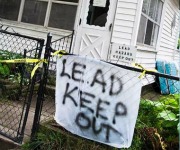 Photo: Steven DepoloHey, have you heard? It’s Lead Poisoning Awareness Week!
Photo: Steven DepoloHey, have you heard? It’s Lead Poisoning Awareness Week!
Stop. I know what you’re thinking.
“We don’t have a ribbon,” says Beth Bingham, communications director for the national Coalition to End Childhood Lead Poisoning. “We get a lot of calls from people wondering what color ribbon they should wear. Everyone else has a ribbon or a bracelet, but we don’t.”
Well that takes the fun out of a festive occasion.
Ah well. Lead poisoning is ugly business, anyway — a little lead in the blood, especially during childhood, is enough to turn your brain to mush. Exhaust from leaded gasoline has been pinpointed as one of the causes of inner-city violence.
The good news? “Lead poisoning is tragic, nasty, awful — and preventable,” says Ruth Ann Norton, the coalition’s executive director. And a hell of a lot of it has been prevented in recent decades. The United Nations announced this week that leaded gasoline has been all but eradicated worldwide, resulting in $2.4 trillion in health, social, and economic benefits each year.
The Coalition to End Childhood Lead Poisoning, started in 1986 by a group of parents whose kids were poisoned, targets another source of the stuff: lead paint, which still lingers in millions of homes. In 2009, the coalition teamed up with the White House and government agencies to create the Green and Healthy Homes Initiative, weaving lead abatement and other health-related work into a $5 billion, stimulus-funded program designed to weatherize homes.
The weatherization program was famously slow to get off the ground, but to date 500,000 homes have been patched up. And in 17 pilot communities, Green and Healthy Homes crews have also gone after mold, pests, and other nasties that trigger asthma, which tops the list of reasons kids miss school. The result, Norton says, is gobs of money saved on health care, particularly for low-income families for whom the emergency room often doubles as the doctor’s office.
“Spend $1,500 to $2,100 to eliminate lead, asthma triggers, and trip-and-fall hazards from a home, and you skip the $50-70,000 a year we spend on Medicaid” for a single sick kid, she says.
The program has worked brilliantly, and other cities are lining up to take part; the coalition estimates that 38 million houses still have serious lead problems. But the stimulus funding will dry up in March, and Congress doesn’t seem inclined to dish out any more billions for this kind of work. “Come March, it’s going to very painful,” Norton says. “They will have to lay off 15,000 people nationwide.”
Hear that? It’s the sound of green jobs going down the toilet.
Even so, Green and Healthy Homes will live on, fueled by a combination of government and philanthropic dollars. And Norton and her colleagues are looking for ways to expand their work. If only they could have just a teeny slice of the money that currently goes to Medicaid. Another possibility is creating a tool that allows the government to invest in cleanup today, and reap the savings tomorrow.
“For every dollar invested in lead poisoning prevention, there’s a $200 or $300 return,” Norton says. The trouble is that those savings don’t begin to show up for 7 or 8 years, when non-lead poisoned kids have dramatically higher reading scores than their poisoned peers. In Washington, that’s a long time to wait for measurable returns.
But the payoffs would continue far into the future: “Third grade reading scores are what determine the need for jail cell beds,” Norton says.
What’s the old saying about an ounce of prevention?
Correction: The original version of this story stated that the funding for Green and Healthy Homes would dry up in March. Not true! The stimulus money dries up in March (thus the 15,000 jobs lost) but Green and Healthy Homes will soldier on with non-stimulus money from the government and foundations. The initiative will need to get creative about its funding if it wants to make more than a small a dent in the problem, however. Apologies for the error!



